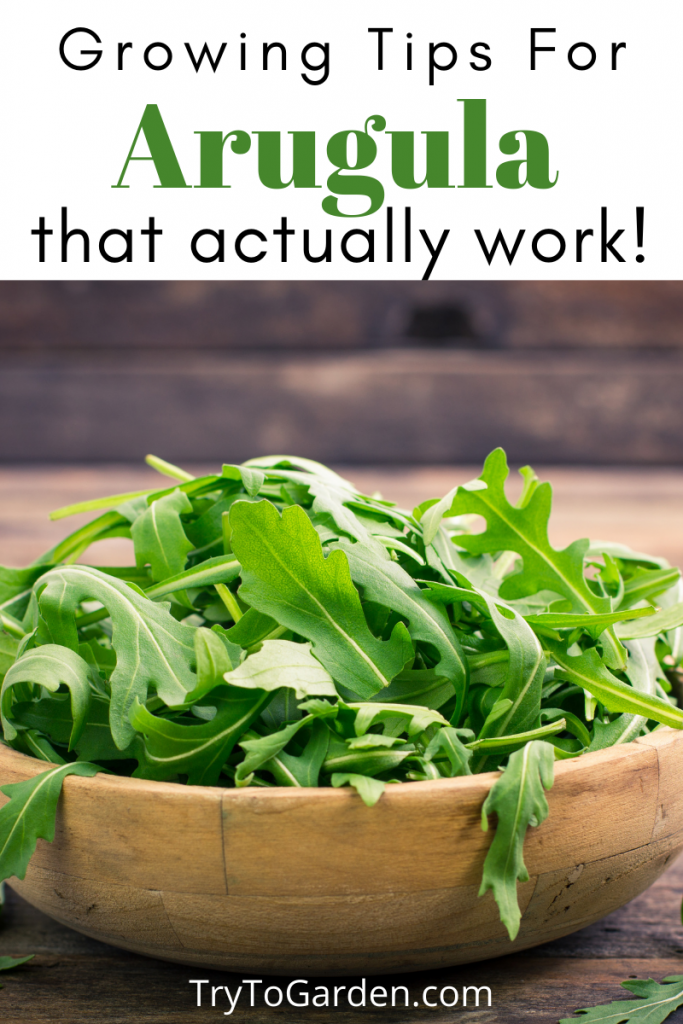This post contains affiliate links, which means I will make a commission at no extra cost to you should you click through and make a purchase. As an Amazon Associate I earn from qualifying purchases.
Gardening Tips for Arugula? Dubbed “rocket lettuce,” arugula is a vibrant salad green that has a wonderfully tangy flavor. Brought to America with the Puritans, this quick-growing green is steadily becoming more popular in backyard gardens. Growing arugula is comparable to other salad greens – they prefer cooler weather. But because it can reach maturity in as little as 40 days, gardeners can plant several crops yearly and enjoy this flavorful vegetable most of the year.

Gardening Tips for Arugula That Actually Work!
Benefits of Arugula
Nutrient-rich and low in calories – just 20 calories in about three cups – arugula provides an excellent source of folate, vitamins A and C, and over 100% of your daily vitamin K needs. This same serving supplies a good source of calcium, magnesium, and manganese.
Basic Arugula Facts
7-10 days. Arugula will also self-seed in many regions.
Arugula is a cool-season annual, meaning that it is good in spring or fall. Plant in full sun and fertile, well-drained soil. Like any herb or vegetable that needs to grow green leaves, arugula will benefit from compost and/or fertilizer. Water when the soil gets dry.
Arugula likes cool weather—45 to 65 degrees Fahrenheit is ideal.
It is suggested to plant 2 Arugula per person in your home. Each arugula seed produces one thin stem, which leaves grow out from. You can further your crop by cutting them back — the leaves will regenerate once or twice before getting too spicy, woody, or bitter.
Arugula can be eaten uncooked or cooked. You can use arugula uncooked in salads, either on its own or in combination with other lettuces. Because it is quite peppery, it is often used as part of a lettuce blend, especially if the arugula is more mature and stronger in taste. It's nice in sandwiches as well.
Gardening Tips for Arugula: Soil
In warmer regions (primarily Zones 3 and warmer), arugula does best in the early spring and fall. The seeds can be planted in garden rows, broadcast in beds, added to mesclun beds, or planted in containers. Choose an area of the garden that is well-draining but also needs adequate moisture to help prevent the plants from bolting and leaves from becoming too bitter.
While arugula can grow in almost any soil type, it does prefer a humus-rich soil with a pH that averages 6.0 to 6.8. Plant seeds either in rows or broadcast in an area of your garden. Plant the seeds about ¼ inch deep and one inch apart. A thin layer of compost can be mixed with the topsoil that covers the seeds.
Arugula does best in nutrient-rich, well-drained soil, but will tolerate a wide variety of conditions. It prefers slightly acidic soil with a pH between 6 and 7. Plant in full sun (6 or more hours of sunlight) for the best results. Arugula will also grow in partial sun.
Planting
The plants do not tolerate extreme heat. Spring plantings should be done at least 40 to 45 days prior to the onset of the summer heat. Plantings can be spaced out every 10 to 14 days to allow for continuous supplies until summer arrives. For fall plantings, begin seeds at the end of summer. Seeds can continue to be planted until about 30 days prior to the first yearly frost date.
The seeds will sprout quickly. If planting in rows, the plants can be thinned to about six inches apart once they are established. The small, tender plants that are thinned out are perfectly edible and can be used in a salad.
Plant Care
The beds or rows can be covered with a floating cover to help prevent garden pests from snacking on the tender leaves. Because this is a cool-weather crop, the plants are generally not bothered by disease or garden pests. However, slugs, beetles, and snails can become a problem as the weather warms. These will need to be hand removed as soon as they are spotted to prevent damage to the leaves.
Arugula plants need ample supplies of water. The soil should stay moist but not water-logged. If the soil is nutrient-rich, feeding is generally not required during the growing season. Once the heat of summer arrives, the plants typically bolt, and the leaves will become bitter.
Gardening Tips for Arugula: Harvesting Arugula
The arugula leaves should reach a generous size for eating at about 30 days after planting. The young leaves can be the tenderest and will be less bitter than larger leaves. To encourage plant growth, cut the outside leaves near the base of the stem first. Most gardeners pick leaves early in the morning when the temperatures are still low if the plant's bolt, the white flowers, and unripe pods can be harvested for salads.
Like most greens, arugula cannot be kept for extended periods of time. Once picked, the fresh leaves should be refrigerated and used as soon as possible.
Enjoying Arugula
Arugula is rich in minerals and vitamin C. It adds a unique flavor to the average salad and is often found in mesclun. But arugula can go beyond the salad plate. It can also be cooked and used as a replacement for other greens like spinach or replace typical herbs used in pesto recipes. Arugula is an excellent addition to homemade pasta dishes and even pizza. Because of the flavor, the culinary uses for arugula are only limited by your imagination.
Easy Arugua Recipe
While I love that peppery taste added to my salad mix, it can be used for a killer pesto too!
